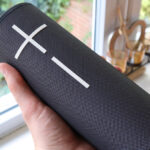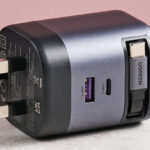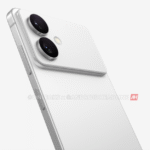Why you can trust TechRadar
We spend hours testing every product or service we review, so you can be sure you’re buying the best. Find out more about how we test.
Netac ZX20 II: 30-second review
The ZX20 II is the follow-up to the small, speedy but expensive ZX20 (see our review here). It’s been a couple of years since the launch of the first-generation SSD, and Netac has gone back to the drawing board. While the USB 3.2 Gen 2×2 interface remains and offers those ultrafast transfer rates, what the company has done is look at the feedback from the first iteration and essentially reworked it into a slightly improved option.
First and foremost, the metal casing is a big step up from the ABS casing of the ZX20. Alongside the increased robustness also comes a Magnetic connector that enables you to utilise this portable SSD with your iPhone and MagSafe to capture ProRes video. This essentially means that not only can you use this as a full working drive, but you can use it all the way from video capture to editing on your laptop or desktop.
Once again, it utilises that USB 3.2 Gen 2×2 interface, which means that on compatible systems that also sport that interface, you’ll see a maximum transfer rate of up to 2000MB/s. However, on any other USB-C port, or, for that matter, Thunderbolt 4 and 3 interfaces, you’ll only see 1000MB/s due to the compatibility issue we’ve we’ve seen so many times before.
While the enhancements are very welcome, there’s still no IP rating for the drive, although it feels even more robust than ever, and there is no status light. Compared with competitors, it is still extremely expensive. That said, to match the price, it now really does feel like a premium product. If you’re you’re in the market for an extremely robust, if not waterproof, portable SSD that you can use for both capturing and editing high-resolution video and data, then the Netac ZX20 II is a superb choice as long as your machine has USB 3.2 Gen 2×2.
Netac ZX20 II: Price & availability
- How much does it cost? £65 / $65
- When is it out? Now
- Where can you get it? Widely available
The Netac ZX20 II is widely available. The 512GB version reviewed here is available for $65 / £65, the 1TB version for $95 / £95, and the 2TB version for $150 / £165. All capacities are available from Amazon.com as well as many other online retailers.
Netac ZX20 II: Design
Specifications
Capacity: 512GB, 1TB & 2TB
USB Interface: USB 3.2 Gen 2×2
Dimensions: 78x46x8mm
Materials: Alloy + Silicone
The first thing that struck me about the Netac ZX20 II over the original ZX20 is the design and build quality. Both look very similar and compact, with that orange detail highlighting the lanyard loop in the top right-hand corner, but there’s a definite more premium feel with the new model. The first striking difference is the fact that it’s got an alloy and silicon build compared with the plastic build of the ZX20, giving it a sturdier feel and helping to dissipate heat when the drive is under load.
When it comes to size and weight, there’s also a difference, with the new model being slightly larger and heavier. The 512GB version reviewed measures 78 x 46 x 8mm and weighs 47g, not including the USB Type-C cable that comes in the box.
Looking at the exterior of the drive, there are also a few design changes, partly due to the material swap, but also with the USB Type-C interface at the bottom of the drive, making for a sleek layout. Unfortunately, like the ZX20, there’s no status LED to show when the drive is in use and accessing data; it’s just an indicator but can be incredibly useful, so it’s a shame they invested in the inclusion.
Another major design change is the inclusion of a magnetic feature, essentially MagSafe, so the drive can connect directly to the back of your iPhone using that MagSafe technology; while the main build of the drive is metal, there’s a rubber pad that just helps to grip the drive to the back of the phone. The ZX20 II plugs into the USB-C port of the iPhone so you can capture ProRes video recordings.
Interestingly, unlike other portable SSDs that highlight this as a major feature, Netac does mention it but keeps it slightly reserved. However, in use, as I’ll cover in the performance section, it works well, enabling you to capture high-resolution, quality ProRes video footage on your iPhone. What’s more, you can then either edit on the phone or unplug the drive and take it back to your laptop or desktop and quickly edit it there.
When it comes to design, this portable SSD has been designed to be used with a laptop, desktop, or mobile device with good compatibility due to the USB-C interface, but you do need to be wary of the USB 3.2 Gen 2×2 interface as you may see a downgrade on performance.
Netac ZX20 II: Features
When it comes to features, this is an extremely small, compact and robust portable SSD. Although it doesn’t come with any IP or MIL-STD ratings rating’s, waterproof or dustproof, you do need to be a little careful when using the drive in inclement conditions. However, it is solidly built and can withstand a knock or two thanks to that full metal build and design, giving it some impact resistance.
For the interface, it uses a USB-C connector and supports the USB 3.2 Gen 2×2 standard. While this can offer up to 2000MB/s, for many laptops and mobile devices, this will be downgraded to 1000MB/s because the USB 3.2 Gen 2×2 interface isn’t common on most consumer hardware.
Even among laptops, it’s rare for the Gen 2×2 interface to be incorporated. More often, you’ll find USB4 ports, in which case the drive’s transfer speeds drop from 2000MB/s to 1000MB/s. This is a very common issue.
In the box, Netac includes both a USB-C to USB-C and a USB-C to USB-A data cable, giving you plenty of compatibility with a range of devices.
A major update since the previous release is Netac’s launch of its Storage Manager app. This adds another dimension to using the drive, especially for PC users; there is no macOS version. The only issue is the software isn’t preinstalled on the drive and must be manually downloaded from the Netac Technology website, and locating it can take a while. It also looks dated, so whether Netac is actively updating the software is debatable.
Netac ZX20 II: Performance
Benchmarks
CrystalDiskMark Read: 2049.11MB/s
CrystalDiskMark Write: 1841.10MB/s
AJA System Test Lite Read: 1807MB/s
AJA System Test Lite Write: 1623MB/s
AS SSD Benchmark Read: 1865.53MB/s
AS SSD Benchmark Write: 1677.15MB/s
ATTO Disk Benchmark Read: 1910MB/s
ATTO Disk Benchmark Write: 1720MB/s
There are some things I’ve come to expect from a portable SSD. The first is strength and robustness, and the ZX20 II, while not boasting any type of IP or MIL-STD certification, certainly feels strong enough; the full metal casing ensures it can withstand a good knock or two. Then there’s the obligatory lanyard loop, and here again, it’s well thought out as it was with the original model. Essentially, it’s a large hole in the top right-hand corner of the drive, so if you want to attach a carabiner, rope or tether hook from your backpack, there’s plenty of space to do that.
As with almost every ultrafast USB portable SSD on the market, it features a USB 3.2 Gen 2×2 interface. While this provides up to 2000MB/s transfer rates, the main issue is finding a machine that actually supports that interface. In this test, I used an Asus desktop machine based on the Asus Prime Z890-P WiFi motherboard with an Intel Core Ultra 7 CPU. This board is equipped with the USB 3.2 Gen 2×2 interface, but when I checked the ProArt P16, P13 and my MacBook Pro M1 Max, while all had USB4 or Thunderbolt 4, the performance of the drive was halved due to compatibility issues.
This is, to be honest, a common issue – so it’s worth checking that your machine has the correct interface to get the most from the drive.
Starting the real-world tests, I connected the drive to my iPhone 15 Pro. Once connected, I launched the Camera app and instantly had access to ProRes video, which would enable me to blend footage from my iPhone with other cameras. The speed and performance of the drive came into its own.
One of the big upgrades from the ZX20 is the new magnetic design, so it attaches to the back of the iPhone and holds in place. The size and shape of the drive also blend nicely with the iPhone’s form, creating a very neat recording setup. Another nice touch is that Netac has included a flat ribbon USB-C to USB-C cable, keeping the setup tidy.
After filming, I could edit the footage directly in CapCut on the iPhone or unplug and connect the drive to one of my machines and edit the footage in DaVinci Resolve or CapCut. Even when capped at 1000MB/s on the MacBook Pro M1 Max, I was able to edit the footage without issue.
Pushing the drive further, I worked with some Canon C-Log footage captured on the Canon EOS R5C shot at 4K resolution at 60fps, editing this on the Asus Prime W890-P based machine via the USB 3.2 Gen 2×2 port in DaVinci Resolve. The driver handled the speed requirements exceptionally well. The only limitation was the 512GB capacity of the review unit, which felt a little tight for the editing workload.
If you’re you’re using this drive for video production, I would strongly recommend the 1TB or 2TB versions instead. For general use, the 512GB capacity offers a good balance of price and space.
I also tested thermal performance, as many small portable SSDs throttle under sustained load. Thanks to the premium metal build, the casing helps dissipate heat. I ran AJA System Test Lite for over an hour. While the drive became warm to the touch, the test continued to run, and transfer rates stayed consistent with the initial run.
Checking the benchmark tests, the drive reached or slightly exceeded 2000MB/s read speeds using the Asus Prime Z890-P motherboard. Write speeds approached 1800MB/s. Even when pushed across all benchmarking tools, the results were impressive. The lowest figures came from AJA System Test Lite, with write speeds of around 1600MB/s and read speeds at about 1800MB/s, still more than enough for most tasks.
Switching to use with a Mac system saw an instant drop in performance, with top-end read speeds of around 1000MB/s and write speeds of around 800MB/s. Even so, when used with DaVinci Resolve, the drive kept up with editing demands.
In testing, the drive proved exceptionally fast for data transfer. While it doesn’t meet any formal rugged certifications, it does feel reliably solid due to the high build quality.
Netac ZX20 II: Final verdict
As a design, Netac has absolutely got the materials, size and aesthetics right for this small portable SSD. It feels solid, and when used on the right system, it keeps up with everything you throw at it; performance doesn’t dip, even after sustained use. However, once again, we have the USB 3.2 Gen 2×2 interface. While it offers up to 2000MB/s transfer rates, which it is capable of delivering, compatibility issues mean that most systems will only access half that performance, which is a real shame.
In terms of design tweaks over the ZX20, it’s definitely a step in the right direction. I just wish that they had included a status LED, but there is the much better metal casing and the continued presence of the lanyard loop and compact size. Hopefully, a future iteration of the drive will address the USB 3.2 Gen 2×2 interface. While it enables high performance, it does so at the cost of wider performance compatibility. A shift to USB4 could let this drive truly show what it’s capable of on all systems, and then that would partly justify the premium pricing.
Essentially, if you have a computer that supports USB 3.2 Gen 2×2, this is a good portable SSD option, even without certifications. However, if your machine doesn’t doesn’t support USB 3.2 Gen 2×2, it’s worth considering more compatible and cost-effective alternatives.
Should I buy a Netac ZX20 II?
|
Value |
While the build quality feels decidedly premium, and it’s backed with strong performance, because of the USB 3.2 Gen 2×2 interface, only a few machines will see the full potential. |
3.5 |
|
Design |
Excellent design with an upgraded metal casing, giving a good, solid, premium feel. |
4.5 |
|
Features |
Standard features that could’ve been improved to match the quality of the excellent build and design. |
3 |
|
Performance |
If you have the correct interface, it’s a solid 5 out of 5; if not, it drops to 3 |
4 |
|
Overall |
This is a great drive. However, due to the USB interface and the price, there’s too much competition for it to clearly stand out. |
3.5 |
Buy it if…
Don’t buy it if…
For more storage solutions, we’ve tested and reviewed the best portable SSD around.
Read the full article here














